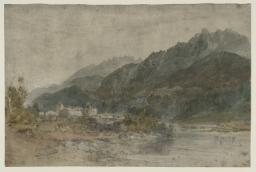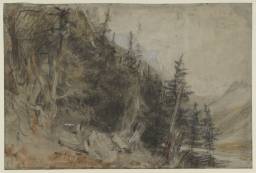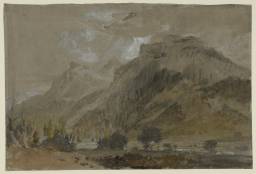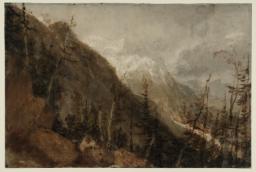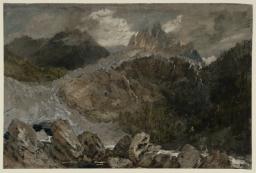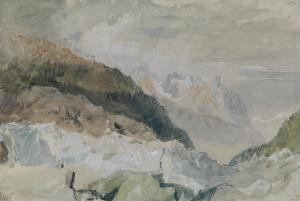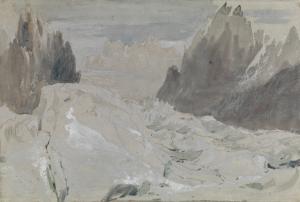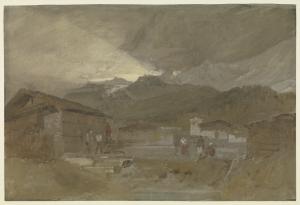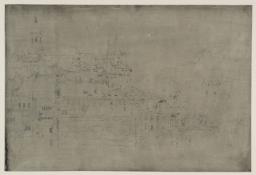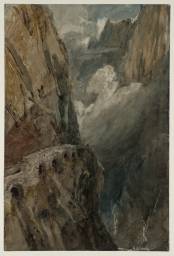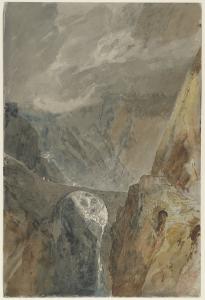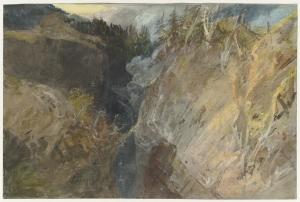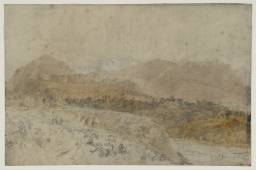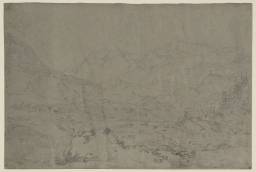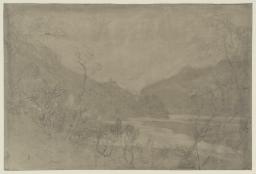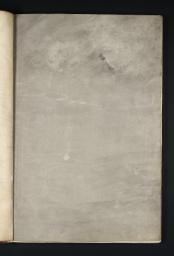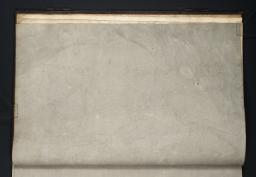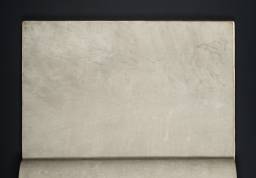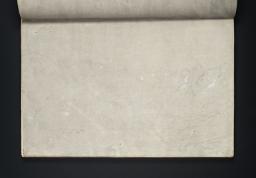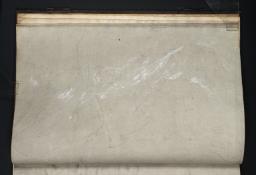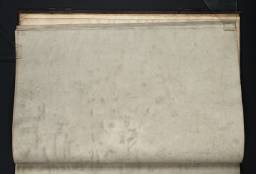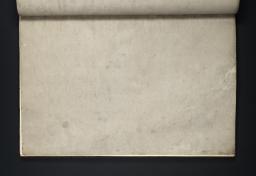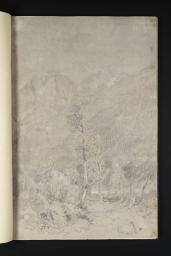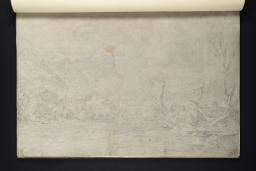Turner Bequest LXXV
Sketchbook, bound in calf, with gold tooling on spine and edges and part of two brass clasps; largely dismembered
Flyleaves of white wove paper; 37 bound and 18 loose leaves of white wove paper, prepared on both sides with grey wash; the loose leaves (now mounted separately) are replaced in the book by modern, blank sheets
Approximate page size 473 x 315 mm
The original leaves made by William Balston and Finch and Thomas Robert Hollingworth at Turkey Mill, Maidstone, Kent, and watermarked ‘1801 | J WHATMAN’
Endorsed by the Executors of the Turner Bequest in ink ‘69’ and initialled in pencil by Charles Lock Eastlake ‘C.L.E.’ and John Prescott Knight ‘JPK’ inside front cover, top left
Inscribed by an unknown hand in red chalk ‘L10’ inside front cover, top left
Inscribed by Arthur Mayger Hind in pencil ‘Replaced in old binding 1935 | Blank leaves added where drawings have | been taken out & mounted and for the one missing (no.52) | A.M.H.’ inside front cover, top left
Stamped in black ‘LXXV’ inside front cover, top left
Flyleaves of white wove paper; 37 bound and 18 loose leaves of white wove paper, prepared on both sides with grey wash; the loose leaves (now mounted separately) are replaced in the book by modern, blank sheets
Approximate page size 473 x 315 mm
The original leaves made by William Balston and Finch and Thomas Robert Hollingworth at Turkey Mill, Maidstone, Kent, and watermarked ‘1801 | J WHATMAN’
Endorsed by the Executors of the Turner Bequest in ink ‘69’ and initialled in pencil by Charles Lock Eastlake ‘C.L.E.’ and John Prescott Knight ‘JPK’ inside front cover, top left
Inscribed by an unknown hand in red chalk ‘L10’ inside front cover, top left
Inscribed by Arthur Mayger Hind in pencil ‘Replaced in old binding 1935 | Blank leaves added where drawings have | been taken out & mounted and for the one missing (no.52) | A.M.H.’ inside front cover, top left
Stamped in black ‘LXXV’ inside front cover, top left
Accepted by the nation as part of the Turner Bequest 1856
References
Turner reserved this large sketchbook for the grandest mountain scenery visited during his Alpine tour in 1802. Although its traditional title follows Turner’s habit of spelling Gotthard as ‘Gothard’ it seems to date back to Finberg and is a mere summary, reversing Turner’s itinerary. In fact he first used it as he approached Grenoble, then at Bonneville and along the River Arve to Chamonix, in the Val d’Aosta, by Lakes Brienz and Thun and only lately in the St Gotthard Pass. Subjects overlap with those in smaller sketchbooks used in 1802; France, Savoy Piedmont (Tate, Turner Bequest LXXIII), Grenoble (Tate, Turner Bequest LXXIV), Rhine, Strassburg and Oxford (Tate, Turner Bequest LXXVII) and Lake Thun (Tate, Turner Bequest LXXVI). However, they are treated more expansively, often with subsequent development in mind.
The size of the leaves of Whatman paper, their preparation in advance with grey wash and the quality of the binding all indicate the importance Turner attached to the book and his intention to use it for more impressive subjects. If he had planned to keep it intact as a record or as a sample of material to show to clients, he changed his mind on returning to London. Instead, he removed the best drawings and mounted them in a large album with a choice of subjects from the Grenoble sketchbook, thus creating a more comprehensive record of his tour; at his death, only six leaves remained in the original book. In the album, the drawings were accompanied by labels with their titles, written by Turner himself. Lists at the front, evidently of works commissioned, in hand or in one case ‘done’, include subjects from this sketchbook as well as from Grenoble. See Technical notes to the Grenoble sketchbook for a fuller account of the album, with transcriptions.
In its turn, the album was broken up by John Ruskin for exhibition purposes; drawings from it first appeared at Marlborough House in 1857. Ruskin’s catalogue notes are characteristically ambiguous in describing their source, as ‘a large volume containing a series of Swiss subjects, treated with greater power than the Grenoble ones’1 could either be the album or the original sketchbook. In any event, Ruskin separated the drawings from their labels, setting those for St Gothard and Mont Blanc subjects (which he mistakenly dated to 1803) aside in a paper wrapper inscribed ‘Titles of the Great Chamouni Series’. He numbered the labels 1–43 (37, 38 and 40 are missing however) and fortunately some of the drawings have corresponding numbers in blue ink, a relationship that David Hill seems to have been first among Turner scholars to observe. There are three unnumbered labels in the same wrapper and fourteen more in another inscribed by Ruskin ‘4th Italian frame’, which may also relate to St Gothard and Mont Blanc drawings. The labels assist greatly in identifying subjects although a few remain uncertain.
Of the leaves distributed by Ruskin, Finberg was able to list fifty. One, a view of Interlaken and Brienz described by Finberg as ‘page 52’ is missing unless a drawing was listed twice (the absence of drawings on touring exhibitions while Finberg was compiling his Inventory could have caused confusion). More finished or coloured drawings were mounted separately, while others were returned to the book, not in the original order. Modern blank sheets were bound in place of mounted leaves. A.M. Hind’s note inside the cover dates this restoration work to 1935.
Finberg, meanwhile, had summarised the earlier history thus:
This book has been almost entirely disintegrated, only six leaves remaining in the covers. No record has been kept of the sequence of the pages. Mr. Ruskin appears to have numbered some of those he had laid down on cartridge, but the numbers evidently refer to some scheme of arrangement of his own, and not to the original order of the pages.
The order in which the pages are now placed is largely fortuitous.
Turner used the sketchbook for drawing on the spot, and must have intended the hard boards to provide a firm support and the grey preparation of the paper to reduce glare while working outdoors. He began with pencil or chalk and worked up from there. Most subjects are of landscape format, but a few are upright, their ‘soaring verticals’ when transferred into finished versions being compared by Andrew Wilton to Turner’s earlier treatments of architecture, especially Gothic cathedrals with their ‘sublime’ scale.2 Moistened and wiped or scratched out, or with the addition of white chalk or gouache, the grey ground lent itself to highlights. It also gave depth when Turner added further colouring. Whether he did this on the spot has been a matter of debate but seems, on the whole, unlikely. Many of the sites depicted were far from easily accessible and Turner must have adapted his media to circumstance. Wilton observes that the watercolour is ‘usually in a very restricted key ... added to a monochrome drawing already tonally complete in itself’.3 As a general rule, Joseph Farington’s description of the Grenoble drawings, when he saw them in London in November 1802, probably applies to this sketchbook as well; ‘Most of the sketches slight on the spot, but touched up since...’4
The coloured drawings from this sketchbook are among the most evocative works to emerge from the 1802 tour, and indeed among Turner’s drawings to date, whether the washes are rich and dense as in an extraordinary close-up of a dark ravine (D04627; Turner Bequest LXXV 25), or little more than a film of green watercolour and white gouache to suggest wooded slopes and the mass of Mont Blanc (D04603; Turner Bequest LXXV 11). As interesting conceptually as technically, the drawings show how classical conventions of composition broke down as Turner approached the wilder Alps. Around Grenoble or Bonneville, Aosta or on Lake Brienz, he could draw with a familiar sense of symmetry. But among the Chamonix glaciers or in the St Gotthard, harsh, unpredictable nature took over; jagged flows and serracs of ice, scattered boulders, withered or twisted trees, dizzying gorges and sheer walls of rock are portrayed straight from life. Ruskin thought these drawings ‘quite stupendous... at the maximum of his early power’,5 and ‘more gloomy in cast of thought’6 than the Grenoble series.
Largely on the basis of this sketchbook, Hill sees Turner as perhaps the first artist to do justice to the Mer de Glace7 and the same could be said of the drawings of the Reuss Valley and St Gotthard Pass. Looking at the gorge of the Reuss from the middle of the Devil’s Bridge (D04625; Turner Bequest LXXV 33), or climbing out on to the Mer de Glace to look back towards the famous viewing hut built by Charles Blair (D04614; Turner Bequest LXXV 22) Turner penetrates the heart of the subject and conveys a powerful sense of raw nature and of the actuality of travel. Nowhere is this felt more strongly than in a view of Les Contamines (D04616; Turner Bequest LXXV 24) where three figures stumble out into a chilly dawn – presumably (as in various Grenoble drawings) they are Turner, Newbey Lowson and their guide, ready for the next day’s trek.
Subjects from the sketchbook were a source of reference for the artist and his clients for years afterwards. Walter Fawkes, whose initial ‘F’ appears on the label for the drawing of Blair’s Hut indicating his order for a finished watercolour (Courtauld Gallery, London),8 began buying works based on the series in 1803 and continued for some years; for Hill, Fawkes is associated with the sketchbook ‘more than anyone else’.9 Its contents must have evoked memories of Fawkes’s Grand Tour as a young man10 when he himself had sketched such scenes, as a friend recalled at the time of his death:
...O Fawkes! By Leman’s side I’ve paced
Admired the giant heights, the cone of snow;
Whilst thou hast sat and all thy grandeur traced,
Or sketched with magic skill the lake below.11
Admired the giant heights, the cone of snow;
Whilst thou hast sat and all thy grandeur traced,
Or sketched with magic skill the lake below.11
Fawkes’s commissions sealed bonds of friendship between artist and patron. Other buyers included Fawkes’s friends the Swinburne family, the banker Samuel Dobree, the wine merchant John Allnutt and John Green of Blackheath. Turner himself chose subjects from the series for the mountain scenes in his series of landscape prints, the Liber Studiorum.
Turner first exhibited pictures based on the sketchbook in 1803. Two shown at the Royal Academy (Yale Center for British Art, New Haven, Connecticut and Museum of Fine Arts, Dallas, Texas)12 were based on the drawing of Bonneville from the Geneva road (D04599; Turner Bequest LXXV 7). Reflecting the town’s historic reputation as a gateway to the Alps (it is now often bypassed by travellers), this proved to be the most productive of all subjects from the book though it is far from the most dramatic. Turner painted another version of Bonneville in 1812 (Philadelphia Museum of Art),13 watercolours for Fawkes (on the London art market in 2007)14 and one for the Swinburne family (British Museum, London)15 and produced the Liber plate Bonneville, Savoy via a subsequent study (Tate D08164; Turner Bequest CXVIII J). The Bonneville subjects, especially where the road into the town echoes the motif of Nicolas Poussin’s Roman Road (Dulwich Picture Gallery), define the classical feeling Turner drew from the approaches to the Alps. Wilder mountain scenery appeared in the 1803 Academy in a watercolour (National Museum of Wales, Cardiff)16 taken from a drawing of the Mer de Glace and source of the River Arveyron (D04613; Turner Bequest LXXV 21). More followed in 1804 when a watercolour (Abbot Hall Art Gallery, Kendal)17 based on the view from the centre of the Devil’s Bridge (D04625; Turner Bequest LXXV 33) hung in the opening exhibition of Turner’s Gallery. Independently and perhaps earlier, Allnutt chose the same subject and the adjoining view of the bridge itself (D04626; Turner Bequest LXXV 34) for versions in oil (City Museum and Art Gallery, Birmingham and private collection).18
Fawkes made by far the largest choice of subjects from the sketchbook. His other commissions comprised a watercolour (private collection)19 based on the drawing of Mont Blanc from Sallanches (D04603; Turner Bequest LXXV 11) and another (private collection)20 based on that of Sallanches and St Martin (D04604; Turner Bequest LXXV 12); five watercolours of scenes around Chamonix, the Montenvers and Mer de Glace (Whitworth Art Gallery, Manchester;21 National Museum of Wales, Cardiff;22 Courtauld Gallery, London;23 Taft Museum, Cincinnati, Ohio;24 Yale Center for British Art, New Haven, Connecticut)25 based on a run of drawings (D04610, D04613, D04614, D04612; Turner Bequest LXXV 18, 21, 22, 20); and a watercolour of the Staubbachfall at Lauterbrunnen (private collection)26 from D04624; Turner Bequest LXXV 32. Not all these are dated but there was an upsurge of activity around 1809. The Chamonix subjects were highlights of Fawkes’s collection when exhibited at his town house in Grosvenor Place in 1819. Significant revisions of their dating and identities have been made by Eric Shanes.27
Liber subjects originating in the sketchbook are as follows: Little Devil’s Bridge (partly from D04628; Turner Bequest LXXV 36); Chain of Alps from Grenoble to Chamberi (from D04618; Turner Bequest LXXV 26); Mer de Glace (from D04615; Turner Bequest LXXV 23); Source of the Arveron (from D04612–13; Turner Bequest LXXV 20–1); Bonneville, Savoy (from D04599; Turner Bequest LXXV 7); and the unpublished Devil’s Bridge (from D04626; Turner Bequest LXXV 34).
Kenneth Garlick and Angus Macintyre eds., The Diary of Joseph Farington, vol.V, New Haven and London 1979, p.1936 (22 November 1822).
E.T. Cook (ed.), Ruskin on Pictures: A Collection of Criticisms by John Ruskin not heretofore Re-printed and now Re-edited and Re-arranged, vol.I, London 1902, p.169; Cook and Wedderburn 1904, p.267.
James Hamilton, ‘Fawkes, Walter Ramsden (1769–1825)’, in Evelyn Joll, Martin Butlin and Luke Herrmann eds., The Oxford Comapanion to J.M.W. Turner, Oxford 2001, p.103.
The Revd. Henry Forster Mills, Elegaic Stanzas Composed on the Death of Walter Fawkes Esquire of Farnley Hall, Bristol 1825.
Butlin and Joll 1984, pp.39–40 no.50 (pl.59), pp.35–6 no.46 (pl.56). For past confusion between the titles and provenances of these pictures, and revision by Andrew Wilton to the identifications given by Butlin and Joll, see notes to D04599; Turner Bequest LXXV 7.
Technical notes
How to cite
David Blayney Brown, ‘St Gothard and Mont Blanc Sketchbook 1802’, sketchbook, October 2011, in David Blayney Brown (ed.), J.M.W. Turner: Sketchbooks, Drawings and Watercolours, Tate Research Publication, August 2014, https://www

